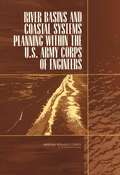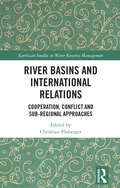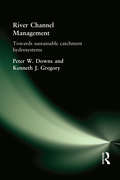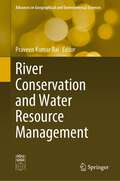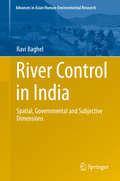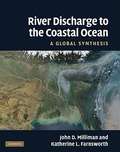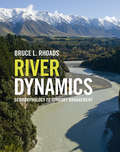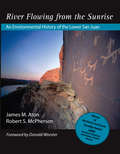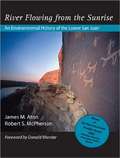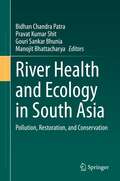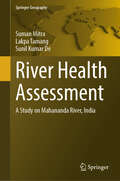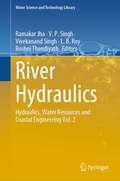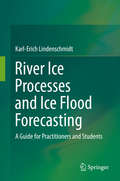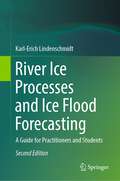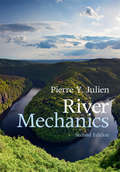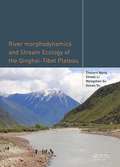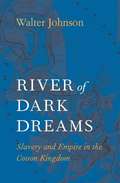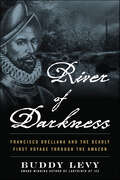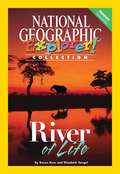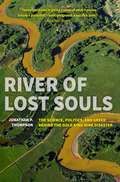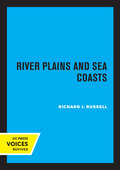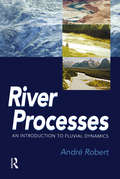- Table View
- List View
River Basins And Coastal Systems Planning Within The U.s. Army Corps Of Engineers
by Panel on River Basin Coastal Systems PlanningFrom the Executive Summary: . . . Recent decades have seen an overall decline in budgets for civil works project construction, yet the range of objectives for water resources projects has broadened as society places more value on environmental and recreational benefits. Thus, the Corps' portfolio of water resource projects has changed considerably.
River Basins and International Relations: Cooperation, Conflict and Sub-Regional Approaches (Earthscan Studies in Water Resource Management)
by Christian PlobergerThis book argues that river basins represent a particular structural setting in international relations with the potential for generating a dynamic of cooperation among the involved countries. The volume applies the concept of regional cooperation to international river basins to highlight their relevance as a particular space in international relations, emphasizing both the inter-connectivity and transnationalism of international river basins. It addresses the challenges related to resource distribution between up- and down-stream countries, showcasing a variety of examples of cooperation and conflictual relations within various international river basins. Case studies are drawn from across the globe and include the Mekong, the Indus, the Euphrates-Tigris and the Danube international river basins. Each chapter outlines the different aspects which support or undermine cooperation in each case, taking into consideration key areas surrounding resource sharing, national development, environmental considerations and national security. This book will be of great interest to students and scholars with an interest in international river basins, regional cooperation, water resource competition, international relations and environmental politics.
River Channel Management: Towards sustainable catchment hydrosystems
by Peter Downs Ken GregoryRiver Channel Management is the first book to deal comprehensively with recent revolutions in river channel management. It explores the multi-disciplinary nature of river channel management in relation to modern management techniques that bear the background of the entire drainage basin in mind, use channel restoration where appropriate, and are designed to be sustainable.River Channel Management is divided into five sections: ·The Introduction outlines the need for river channel management .·Retrospective Review offers an overview of twentieth century engineering methods and the ways that river channel systems operate. ·Realisation explains how greater understanding of river channel adjustments, channel hazards and river basin planning created a context for twenty-first century management.·Requirements for Management explains and examines environmental assessment, restoration-based approaches, and methods that work towards 'design with nature'·Final Revision speculates about prospects for twenty-first century river channel management. River Channel Management is written for higher-level undergraduates and for postgraduates in geography, ecology, engineering, planning, geology and environmental science, for professionals involved in river channel management, and for staff in environmental agencies.
River Conservation and Water Resource Management (Advances in Geographical and Environmental Sciences)
by Praveen Kumar RaiThis book presents an up-to-date, systematic and scientific analysis of water resource problems in India and suggests measures to overcome them through effective water management. In addition, the book provides an overview of how changes in legislation, policies, institutional responsibilities, science, technology, practical techniques and public perception have influenced the ways of river management over the past years. River water conservation is a planned activity connected with various habitat features and outlines how to conserve all river water spread across the world. The restoration and conservation of river water must be of the highest priority for sustaining humanity and ecology for the present and future generations. In order to solve the water problems, conservation and recycling of water should be made mandatory for all domestic, industrial and agricultural projects. Apart from the priority to watershed development, rainwater harvesting and other appropriate conservation measures should be adopted to create awareness among the public so that their mind-set, attitudes and habits change proactively and they adopt sustainable practices rather than wait for legislation and regulations. The book augments the knowledge base of behaviour of rivers and evaluates the issues related to rivers so as to develop river system management techniques emerging from in-depth scientific analyses. It is useful for students, researchers, water resource managers, hydrologists and all those who are engaged or interested in any aspect of river water conservation and management of water resources in the country.
River Control in India
by Ravi BaghelLarge river systems throughout the planet have been dramatically transformed due to river control projects such as large dams and embankments. Unlike other major human impacts like anthropogenic climate change, the alteration of river systems has been deliberate and planned by a small, powerful set of experts. Taking India as a case study, this book examines the way experts transform the planet through their discourse by their advocacy of river projects. This book identifies the spatial aspects of the norms through which the ideal river and the deficient river in need of control are produced. The role of governmental rationality in explaining the seemingly irrational and counter-productive effects of large projects like Kosi river embankments is considered. Finally using autobiographical material, the subjectivity of expert advice is examined, questioning its presumed objectivity. By examining the different subjective stances arising from the same body of expertise, this book discusses the consequences this has for river control specifically and for the relation between expertise and environmental change in general.
River Discharge to the Coastal Ocean
by Katherine L. Farnsworth John D. MillimanRivers provide the primary link between land and sea. Utilizing the world's largest database, this book presents a detailed analysis and synthesis of the processes affecting fluvial discharge of water, sediment and dissolved solids. The ways in which climatic variation, episodic events, and anthropogenic activities - past, present and future - affect the quantity and quality of river discharge are discussed in the final two chapters. The book contains 26 tables and more than 165 figures - many in full color - including global and regional maps. The book's extensive appendix presents the 1534-river database as a series of 44 tables and 132 maps that provide quantitative data regarding the discharge of water, sediment and dissolved solids. The complete database is also presented within a GIS-based package available online at www.cambridge.org/milliman. River Discharge to the Coastal Ocean provides an invaluable resource for researchers, professionals and graduate students in hydrology, oceanography, geology, geomorphology and environmental policy.
River Dynamics: Geomorphology to Support Management
by Bruce L. RhoadsRivers are important agents of change that shape the Earth's surface and evolve through time in response to fluctuations in climate and other environmental conditions. They are fundamental in landscape development, and essential for water supply, irrigation, and transportation. This book provides a comprehensive overview of the geomorphological processes that shape rivers and that produce change in the form of rivers. It explores how the dynamics of rivers are being affected by anthropogenic change, including climate change, dam construction, and modification of rivers for flood control and land drainage. It discusses how concern about environmental degradation of rivers has led to the emergence of management strategies to restore and naturalize these systems, and how river management techniques work best when coordinated with the natural dynamics of rivers. This textbook provides an excellent resource for students, researchers, and professionals in fluvial geomorphology, hydrology, river science, and environmental policy.
River Flowing From The Sunrise: An Environmental History of the Lower San Juan
by James M Aton Robert McPhersonThe authors recount twelve millennia of history along the lower San Juan River, much of it the story of mostly unsuccessful human attempts to make a living from the river's arid and fickle environment. From the Anasazi to government dam builders, from Navajo to Mormon herders and farmers, from scientific explorers to busted miners, the San Juan has attracted more attention and fueled more hopes than such a remote, unpromising, and muddy stream would seem to merit.
River Flowing from the Sunrise
by James M. Aton Robert S. McphersonThe authors recount twelve millennia of history along the lower San Juan River, much of it the story of mostly unsuccessful human attempts to make a living from the river's arid and fickle environment. From the Anasazi to government dam builders, from Navajo to Mormon herders and farmers, from scientific explorers to busted miners, the San Juan has attracted more attention and fuelled more hopes than such a remote, unpromising, and muddy stream would seem to merit.
River Health and Ecology in South Asia: Pollution, Restoration, and Conservation
by Bidhan Chandra Patra Pravat Kumar Shit Gouri Sankar Bhunia Manojit BhattacharyaThis volume reviews recent hydrological and environmental issues resulting from human-induced water pollution practices while providing case studies on the physical, chemical, and eco-biological techniques used to mitigate the impacts of river ecosystem pollution in South Asian countries. The book demonstrates the key methods of measurement, monitoring, mapping, and modeling of river water quality and how it is impacted by pollution and incorporates contemporary geospatial technological applications for the management and sustainability of future water resources. The major topics that the book addresses are the fundamental concepts of river ecosystem health, riverine ecology and habitats, risk assessment of riverine pollution, and technology-based river pollution control strategies. The book will serve as an interdisciplinary guide for researchers, students, and GIS specialists working in various disciplines, including pollution hazards, river ecosystem restoration, water quality, remote sensing, zoology, natural resources management, and environmental geography.
River Health Assessment: A Study on Mahananda River, India (Springer Geography)
by Suman Mitra Lakpa Tamang Sunil Kumar DeThis book provides in detail assessment of the health of Mahananda river, an important head water river system in the Darjeeling Sub-Himalayas which is getting altered rapidly with the pace of human interference. It covers all aspects of river health monitoring through an effective method combining geospatial analysis and field measurements for the assessment of the hydromorphological, hydrochemistry, and hydrobiological quality which indicates that it is neither maintaining its overall fluvial characteristics and functions, nor can quickly replenish, supporting local biota and sediment transport. This book also identifies the factors responsible for existing health condition and suggests target-oriented restoration measures for the sustenance of river health essential for restoring the hydro-ecological balance of one of the most degraded river. The book can be utilized as reference materials by academics, practitioners, and decision-makers for the health assessment of other river basins.
River Hydraulics: Hydraulics, Water Resources and Coastal Engineering Vol. 2 (Water Science and Technology Library #110)
by Ramakar Jha V. P. Singh Vivekanand Singh L. B. Roy Roshni ThendiyathThis book presents key principles of the hydraulics of river basins, with a unique focus on the interplay between stream flows and sediment transport. Addressing a number of basic topics related to the hydraulics of river systems, above all it emphasizes applicative aspects in order to provide the reader with a solid grasp of river engineering. The understanding of the river hydraulics is essential for the assessment of optimum locations for the conservation of water resources and its structures. This book will be interesting to readers and researchers working in the specialized area of river hydraulics of Ganga basin, Narmada, Tapi, Godavari, and other basins of India. It consists of review on hydraulics of meandering river; hydraulic design of reservoir in permeable pavement; optimization of hydraulic design; hydraulic investigations to optimize the design of spillway and design of energy dissipater; and analysis of performance of orifice spillway using computational fluid dynaics
River Ice Processes and Ice Flood Forecasting: A Guide for Practitioners and Students
by Karl-Erich LindenschmidtThis book exposes practitioners and students to the theory and application of river and lake ice processes to gain a better understanding of these processes for modelling and forecasting. It focuses on the following processes of the surface water ice: freeze-up, ice cover thickening, ice cover breakup and ice jamming. The reader will receive a fundamental understanding of the physical processes of each component and how they are applied in monitoring and modelling ice covers during the winter season and forecasting ice floods. Exercises accompany each component to reinforce the theoretical principles learned. These exercises will also expose the reader to different tools to process data, such a space-borne remote sensing imagery for ice cover classification. A thread supporting numerical modelling of river ice and lake ice processes runs through the book.
River Ice Processes and Ice Flood Forecasting: A Guide for Practitioners and Students
by Karl-Erich LindenschmidtThis book exposes practitioners and decision-makers to the theory and application of river ice processes to gain a better understanding of these processes for modelling and ice flood hazard and risk assessment. It focuses on the following processes of the surface water ice: river freeze-up and flooding, mid-winter ice-cover breakup and flooding and end-of-winter ice-cover breakup and ice jamming. The reader will receive a fundamental understanding of the physical processes of each component and how they are applied in monitoring, modelling and flood hazard/risk assessment of river ice during the entire winter season, from freeze-up to potential mid-winter breakup and concluding with springtime ice-cover breakup and ice-jam flooding. Spreadsheet, geographical information system (GIS) and modelling exercises accompany each component to reinforce the theoretical principles learned. Step-by-step tutorial videos allow the reader to better engage with the book and learn the material faster.
River Mechanics (2nd Edition)
by Pierre Y. JulienThe second edition of Julien's textbook presents an analysis of rivers from mountain streams to river estuaries. The book is rooted in fundamental principles to promote sound engineering practice. <P><P>State-of-the-art methods are presented to underline theory and engineering applications. River mechanics blends the dual concepts of water conveyance and sediment transport. Like the first edition, this textbook contains ample details on river equilibrium, river dynamics, bank stabilization, and river engineering. Complementary chapters also cover the physical and mathematical modeling of rivers. As well as being completely updated throughout, three new chapters have been added on watershed dynamics, hillslope stability, and stream restoration. Throughout the text, hundreds of examples, exercises, problems, and case studies assist the reader in learning the essential concepts of river engineering. The textbook is very well illustrated to enhance advanced student learning, while researchers and practitioners will find the book to be an invaluable reference.<P> Presents a detailed analysis of rivers from the mountains to the oceans: readers will benefit from an integrated view of rivers rather than a fragmented stream versus rivers approach,<P> Numerous worked examples, data sets, exercises, and solved problems will help advanced students and researchers in their understanding of river mechanics,<P> The second edition has been brought completely up-to-date, with new sections on hillslope stability, river meandering, and stream restoration, providing readers with a broader base for the analysis of rivers and environmental considerations,.
River Morphodynamics and Stream Ecology of the Qinghai-Tibet Plateau
by Zhaoyin Wang Zhiwei Li Mengzhen Xu Guoan YuThis book focuses on the river morphodynamics and stream ecology of the Qinghai-Tibet Plateau. The objective of the book is to summarize and synthesize the recent studies based on field surveys undertaken in the period 2007-2014. This book was written to serve as a graduate-level text for a course in river dynamics and stream ecology and as a refer
River Networks as Ecological Corridors: Species, Populations, Pathogens
by Andrea Rinaldo Marino Gatto Ignacio Rodriguez-IturbeRiver networks are critically important ecosystems. This interdisciplinary book provides an integrated ecohydrological framework blending laboratory, field, and theoretical evidence that changes our understanding of river networks as ecological corridors. It describes how the physical structure of the river environment impacts biodiversity, species invasions, population dynamics, and the spread of waterborne disease. State-of-the-art research on the ecological roles of the structure of river networks is summarized, including important studies on the spread and control of waterborne diseases, biodiversity loss due to water resource management, and invasions by non-native species. Practical implications of this research are illustrated with numerous examples throughout. This is an invaluable go-to reference for graduate students and researchers interested in river ecology and hydrology, and the links between the two. Describing new related research on spatially-explicit modeling of the spread of waterborne disease, this book will also be of great interest to epidemiologists and public health managers.
River of Dark Dreams: Slavery and Empire in the Cotton Kingdom
by Walter JohnsonRiver of Dark Dreams places the Cotton Kingdom at the center of worldwide webs of exchange and exploitation that extended across oceans and drove an insatiable hunger for new lands. This bold reaccounting dramatically alters our understanding of American slavery and its role in U. S. expansionism, global capitalism, and the upcoming Civil War.
River of Darkness: Francisco Orellana and the Deadly First Voyage through the Amazon
by Buddy LevyThe acclaimed author of Conquistador and Labyrinth of Ice charts one of history’s greatest expeditions, a legendary 16th-century adventurer’s death-defying navigation of the Amazon River. In 1541, Spanish conquistador Gonzalo Pizarro and his lieutenant Francisco Orellana searched for La Canela, South America’s rumored Land of Cinnamon, and the fabled El Dorado, “the golden man.” Quickly, the enormous expedition of mercenaries, enslaved natives, horses, and hunting dogs were decimated through disease, starvation, and attacks in the jungle. Hopelessly lost in the swampy labyrinth, Pizarro and Orellana made the fateful decision to separate. While Pizarro eventually returned home in rags, Orellana and fifty-seven men continued into the unknown reaches of the mighty Amazon jungle and river. Theirs would be the greater glory. Interweaving historical accounts with newly uncovered details, Levy reconstructs Orellana’s journey as the first European to navigate the world’s largest river. Every twist and turn of the powerful Amazon holds new wonders and the risk of death. Levy gives a long-overdue account of the Amazon’s people—some offering sustenance and guidance, others hostile, subjecting the invaders to gauntlets of unremitting attacks and signs of terrifying rituals. Violent and beautiful, noble and tragic, River of Darkness is riveting history and breathtaking adventure that will sweep readers on a voyage unlike any other.
River of Dust: The Life-Giving Link Between North Africa and the Amazon
by Jilanne HoffmannOver and Under the Rainforest meets This Is How We Do It in A River of Dust—a celebration of global interconnectedness with an environmental lens, at a time when we need it most.I am dust,the dust of North Africa.I connect continents. The dust of the Sahel—a ribbon of land between the Sahara and the savannah—lifts with the harmattan wind each winter season. But this is not just any dust. The Sahel's dust will mix with dust from the Sahara and travel thousands of miles westward, across the African continent and the Atlantic Ocean, to reunite with its unforgotten home deep in the Amazon basin. Told in the perspective of dust, A River of Dust takes readers on a journey through vibrantly illustrated landscapes, celebrating the power and wonder of Earth's ecosystems, and showing how these tiny particles are in fact key to the health of our planet. Meticulously researched and lushly illustrated, this picture book is a lyrical ode to global interconnectedness and the vital roles that even the smallest play in taking care of our planet.GLOBAL CONNECTIVITY: Just like This Is How We Do It, this book emphasizes global connectivity: the Amazon can't succeed by itself, and we all have a role to play.SMALL PARTICLES, MIGHTY IMPACT: This powerful story of the Sahel's very necessary contribution to the world demonstrates how seemingly inconsequential particles are key to the health of our planet. And if dust can be so important, readers will imagine the impact each one of them can have on the world around them.EDUCATIONAL TOOL: With strong STEM themes, this offers plenty of opportunities to incorporate into lesson plans, from units on geography and environmental science, particularly lessons on the rainforest, global warming, and interconnected ecosystems.SOOTHING LULLABY: Poetic and yearning, this picture book has a gentle message that reassures its readers about remaining connected despite time and distance with an affirmation of love that parents will enjoy sharing with their children.ARTFUL & LUSH: Vivid landscapes, from the deserts of Africa to the rainforests of the Amazon, by illustrator Eugenia Mello, make this lyrical picture book come to life. Note the gorgeous spattering of foil dust on the jacket, which makes this cover glow!WANT TO LEARN MORE?: Meticulously researched information included at the back of the book provides insight and compelling scientific facts for readers who are curious to know more. Did you know that there are more trees in the Amazon than stars in the Milky Way galaxy?Perfect for:Resource for teachers and librarians seeking books about nature, the earth, and ecology for kidsParents looking for non-fiction picture books and science books for childrenA beautiful environmental picture book and lyrical story for anyone interested in learning about ecosystems and the environmentFans of Over and Under the Rainforest, Over and Under the Pond, and other popular nature books for young readers
River of Life
by Debbie S. MillerAs the seasons change, a river in Alaska reveals its remarkable biodiversity. A great web of life is presented--the river and its shores sustain an astonishing variety of plants and animals. The river is home: salmon fry and rainbow trout live in it, plankton drifts in its current. The river is food: bears and bald eagles catch salmon, big fish chase little fish, tree roots absorb the river water. This evocative nonfiction picture book follows a year in the life of this Alaskan river. The lyrical text and lush paintings introduce young readers to the sights and sounds of the river and its inhabitants and are rich in details certain to fascinate ecologists of all ages.
River of Lost Souls: The Science, Politics, and Greed behind the Gold King Mine Disaster
by Jonathan ThompsonAward–winning investigative environmental journalist Jonathan P. Thompson digs into the science, politics, and greed behind the 2015 Gold King Mine disaster, and unearths a litany of impacts wrought by a century and a half of mining, energy development, and fracking in southwestern Colorado. Amid these harsh realities, Thompson explores how a new generation is setting out to make amends. <p><p> As shocking and heartbreaking as the Gold King spill and its aftermath may be, it's merely the tip of the proverbial iceberg. The disaster itself was the climax of the long and troubled story of the Gold King mine, staked by a Swedish immigrant back in 1887. And it was only the most visible manifestation of a slow–moving, multi–faceted environmental catastrophe that had been unfolding here long before the events of August 5, 2015.
River Plains and Sea Coasts
by Richard J. RussellThis title is part of UC Press's Voices Revived program, which commemorates University of California Press’s mission to seek out and cultivate the brightest minds and give them voice, reach, and impact. Drawing on a backlist dating to 1893, Voices Revived makes high-quality, peer-reviewed scholarship accessible once again using print-on-demand technology. This title was originally published in 1967.
RIVER PROCESSES: An introduction to fluvial dynamics
by Andre RobertRiver Processes deals primarily with flow and sediment dynamics in alluvial channels. It emphasises water flows (basic principles and characterisation), fluvial sediment, processes of erosion and sediment transport, bedforms that result from flow-bed sediment interactions in sand and gravel, flow and sedimentary processes in curved, braided and confluent channels, as well as aquatic habits.River Processes provides a comprehensive synthesis of current knowledge about physical processes in alluvial channels, with an emphasis on the recent work on flow-bed-sediment transport interactions. It is intended primarily for undergraduate students interested in fluvial studies as part of physical geography, earth sciences, environmental sciences and ecology courses. The textbook is fully illustrated throughout with line drawings and photographs.
